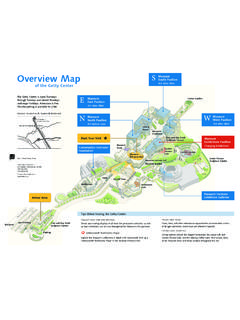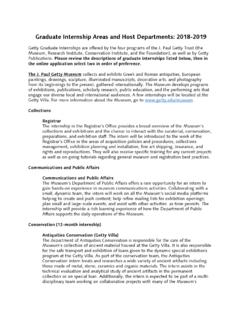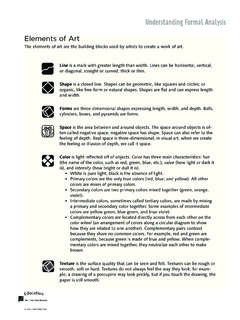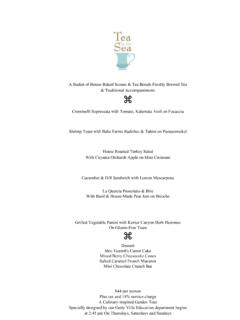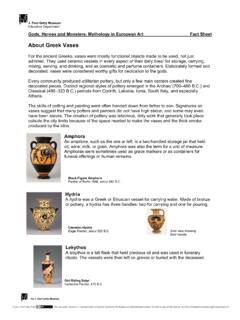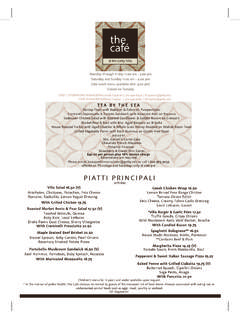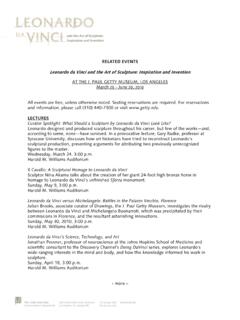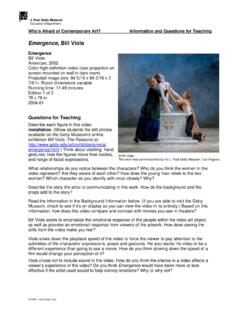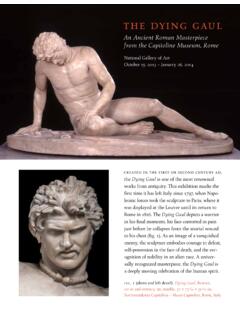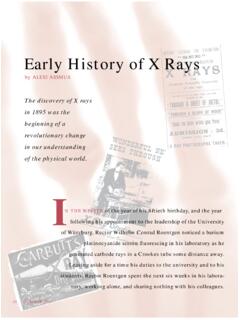Transcription of Race and Racism in the European Middle Ages
1 Race and Racism in the European Middle ages Geraldine Heng, University of Texas at Austin Initial Q: Two Soldiers Leading Two Moors before a King (detail), about 1290 1310, unknown illuminator and Michael Lupi de andiu, scribe. Tempera colors, gold leaf, and ink on parchment, 14 3/8 9 7/16 in. The J. Paul Getty Museum, Ms. Ludwig XIV 6, fol. 244. Digital image courtesy of the Getty s Open Content Program For generations, race studies scholars historians, literary critics, social scientists believed that race and its pernicious spawn, Racism , were modern-day phenomena only. This is because race was originally defined only in biological terms, and believed to be determined by skin color, physiognomy, and genetic inheritance. The more astute, however, came to realize that race could also be a matter of cultural classification, as Ann Stoler s 1977 study of the colonial Dutch East Indies makes plain: Race could never be a matter of physiology alone.
2 Cultural competency in Dutch customs, a sense of belonging in a Dutch cultural with things arrangements, parenting styles, and moral crucial to was to be considered European . Yet even after we recognized that people could be racialized through cultural and social criteria that race could be a social construction the European Middle ages was still seen as outside the history of race. (I speak only of the European Middle ages because I m a J. Paul Getty Trust. Licensed under a Creative Commons Attribution International License (CC BY ) 2 euromedievalist it s up to others to discuss race in Islamic, Jewish, Asian, African, and American premodernities.) This meant that the atrocities of the medieval period roughly 500 to 1500 CE such as the periodic exterminations of Jews in Europe, the demand that they mark their bodies and the bodies of their children with a large visible badge, the herding of Jews into specific towns in England to monitor their livelihoods, and the vilification of Jews for supposedly possessing a fetid stench, a male menses, subhuman and bestial qualities, and a congenital need to ingest the blood of Christian children whom they tortured and crucified to death: All these and more were considered to be just premodern prejudice and not acts of Racism .
3 My book The Invention of Race in the European Middle ages suggests that the exclusion of the medieval period from the history of race issues derives from an understanding of race that has been overly influenced by the era of scientific Racism (in the so-called Age of Enlightenment ), when science was the magisterial arbiter of racial classification. But today, in news media and public life, we see how religion also can function to classify people in absolute and fundamental ways for instance, Muslims, who hail from a diversity of ethno-races and national origins, have been talked about as if their religion somehow identified them as one homogenous people. The Invention of Race thus puts forward an understanding of race more apposite to our time, as well as to medieval time: Race is one of the primary names we have a name we retain for the commitments it recognizes that is attached to a repeating tendency, of the gravest import, to demarcate human beings through differences among humans that are selectively identified as absolute and fundamental, so as to distribute positions and powers differentially to human groups.
4 In race-making, strategic essentialisms are posited and assigned through a variety of practices: Race is thus a structural relationship for the management of human differences, rather than a substantive content. Instead of opposing premodern prejudice to modern racisms, we can then see the treatment of medieval Jews including their legalized murder by the state on the basis of community rumors and lies as racial acts, which today we might even call hate crimes, of a sanctioned and legalized kind. In this way, we would bear witness to the full meaning of events in the medieval past, and understand that racial thinking, racial practices, and racial phenomena can occur before there was a vocabulary to name them for what they are. To discuss medieval race, I ve scrutinized a wide range of evidence: art and statuary, maps, saints lives, state legislature, church laws, social institutions, popular beliefs, economic J.
5 Paul Getty Trust. Licensed under a Creative Commons Attribution International License (CC BY ) 3 relations, war, settlement and colonization, religious treatises, and many kinds of literature (travel accounts, ethnographies, romances, chronicles, letters, papal bulls, etc.). I ve suggested that medieval England is the first racial state in the history of the West. English church and state laws produced surveillance, tagging, herding, incarceration, legal murder, and finally, the expulsion of English Jews. A popular story of Jews killing Christian boys which began in England and spread throughout the continent shifts in marked ways across a century, told and retold to consolidate the communal identity of England as a nation united against Jews, who became an internal minority of perpetual outsiders. In 1215, Canon 68 of the Fourth Lateran Council installed racial law in the Latin West by ordering Jews and Muslims to mark themselves off by a difference of dress.
6 English laws and statutes quickly elaborated this into a badge of shame and increasingly constricted the freedom of Jewish subjects, till in 1275, the Statute of Jewry created residential enclaves the beginnings of the ghetto by forbidding Jews from living among Christians. By 1290, parliamentary law drove Jews from England altogether, in their first permanent expulsion from a European country. Concomitantly, Muslims were turned into non-humans, with the renowned theologian Bernard of Clairvaux, who co-wrote the Rule for the Order of the Templars, announcing that the killing of a Muslims wasn t actually homicide, but malicide the extermination of incarnated evil, not the killing of a person. Ingeniously, authors and theologians in Europe repeatedly called Muslims Saracens a made-up name that falsely claimed Muslims called themselves Saraceni to pretend they were descended from Sara, Abraham s legitimate wife, and not Hagar, her bondwoman, because of their shame a story that characterized Muslims as liars, in the very act of telling a lie about them.
7 The extraterritorial incursions we call the Crusades even created an indispensable template for Europe s later colonial empires of the modern eras, by creolizing the old template of Roman colonization. When Europeans later came to subjugate the populations of the world and spread new maritime empires, they came with the Book and the Sword not like ancient Rome, but like medieval Christendom. Even fellow Christians could be racialized: Gerald of Wales justified England s invasion of Ireland in the twelfth century by depicting the Irish as a subhuman, savage, and bestial race a racializing strategy in England s colonial rule of Ireland that echoed from the medieval through the early modern period: Four centuries later, Edmund Spenser would repeat the same derogatory lies about the bestial, savage, inhuman Irish. Europeans, of course, knew of the existence of sub-Saharan Africans, whom they met on pilgrimage to Jerusalem, and in the trading ports of the Mediterranean.
8 Thanks to Ethiopia s Christianization in the fourth century, and Nubia s in the sixth, pious Ethiopian priests served J. Paul Getty Trust. Licensed under a Creative Commons Attribution International License (CC BY ) 4 at the Holy Sepulcher, alongside devout pilgrims from Africa. Yet sub-Saharan Africans continued to be depicted as the torturers of Christ and killers of John the Baptist in European art. In literature, Africa invited fantasies of what the outside world could offer treasure, sex, wealth, supremacy if the West could only make the world more like Latin Christendom itself. And so, the patron saint of Magdeburg Cathedral, St. Maurice a martyr venerated for a thousand years was suddenly depicted in 1220 as a black African: a way to make Africa mobile and transportable to the heartlands of the Holy Roman Empire, where Africa s hallowed past of church fathers and holy ascetics could be recalled, displayed, and owned, in an era of disappointing crusading failure and Islamic dominance.
9 Europeans also encountered Native Americans early in the eleventh century, when Greenlanders and Icelanders founded settlements in North America. Icelandic sagas gleefully show the natives being bilked and cheated by the new settler-colonists in exploitative trade relations half a millennium before Columbus. The colonists even kidnap two native boys and abduct them back to Europe, forcibly Christianizing the children and teaching them Norse an account of forced emigration that may explain why, among the races of the world, scientists tell us the C1e DNA gene element is shared only by Icelanders and Native Americans today. Medieval Europe also had an evolving relationship with the Mongol race. Studying Franciscan missionary accounts, the famous narrative of Marco Polo and Rustichello of Pisa, Franciscan letters from China, the journey of Rabban Sauma, a monk of the Church of the East from Beijing to Europe, and other travel narratives, will show you how Mongols transformed from a hideously monstrous alien race into an object of desire for the Latin West, once the Mongol Empire s wealth, power, and vast resources became known.
10 Mongols even offered the West a vision of modernity, of what that future might look like with a postal express, disaster relief, social welfare, self-maintained census data collection by the citizenry, independent women leaders, and paper money that was universally accepted. Unlike other races encountered by Latin Christendom Jews, Muslims, Africans, Native Americans, and the Romani Mongols were the only race representing absolute power, to a fearful West. The medieval period was also a period of thriving international slavery. Caucasian slave women in Al-Andalus (Islamic Spain) birthed heirs for Muslim rulers, so that for generations, the Caliphs of C rdoba were blond-haired, blue-eyed men, except for one (who was red-haired, and reportedly dyed his hair black to look more Arab). European human traffickers especially Italian slavers over the centuries resupplied the Mamluk dynasties of Egypt with Turkic and Caucasian slaves who became formidable military elites and Sultans, thus facilitating the ultimate loss of all the crusader territories to the Mamluks, and ensuring Islamic domination of the Holy Lands.
